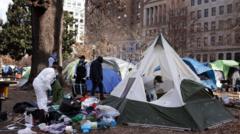Should Homeless People Be Forced to Leave Washington DC?

Understanding the Current Homelessness and Crime Debate in Washington D.C.
The ongoing conversation surrounding homelessness and crime in Washington D.C. has become a focal point of political discourse, particularly with President Donald Trump's recent comments and actions. As crime rates fluctuate and the homeless population persists, the dynamics between local government and federal authority are increasingly scrutinized. In this article, we will delve into the complexities of homelessness, the responses from local officials, and the implications of federal intervention. We aim to provide a comprehensive understanding of the situation, analyzing various viewpoints and potential solutions for the future.
The Current State of Homelessness in Washington D.C.
Homelessness is a pressing issue in Washington D.C., affecting thousands of residents. According to estimates from local organizations, about 3,782 individuals experience homelessness on any given night. While the majority find shelter in public housing or emergency accommodations, approximately 800 individuals are considered "on the street," facing the harsh realities of life without stable shelter.
This issue is not merely a result of economic hardship; it intertwines with various factors such as mental health, addiction, and access to affordable housing. In recent years, the local government has made strides in reducing homelessness through various initiatives. However, the challenge remains significant due to the city's limited resources and the growing demand for services.
Political Responses to Homelessness
President Trump's recent statements regarding homelessness in Washington D.C. have sparked significant debate. He has called for the immediate removal of homeless individuals from the city, asserting his commitment to restoring order and safety. Trump's approach has been characterized by a combination of tough rhetoric and proposed solutions that include moving homeless people to designated areas outside the capital.
In contrast, D.C. Mayor Muriel Bowser has defended her administration’s efforts, emphasizing that crime rates have been decreasing and that the city is not experiencing the alarming crime spike described by Trump. She has pointed out that the city's homicide rate, while still high, has been lower than in previous years, and overall violence has been at a 30-year low.
Crime Rates and Public Safety Concerns
Crime rates in Washington D.C. have fluctuated over the years, with certain types of crime, such as homicides, drawing significant media attention. As of now, the D.C. homicide rate remains high compared to other U.S. cities, with 98 recorded homicides this year. However, federal data indicates that the city achieved its lowest overall violent crime figures in 2022, suggesting a complex narrative regarding public safety.
Trump has argued that the capital has become increasingly dangerous and unclean, proposing that federal law enforcement be deployed to combat the perceived rise in crime. Following a violent incident involving a former government employee, Trump ordered an increase in federal presence, claiming it is necessary to restore safety and order in the streets of D.C.
Local vs. Federal Authority in Addressing Homelessness
One of the critical aspects of this issue is the balance of power between local and federal authorities. Washington D.C. operates as a district overseen by the federal government, which has the ability to override local laws. This dynamic complicates the city's ability to manage its own affairs, particularly in matters related to policing and homelessness.
Mayor Bowser has expressed concern over Trump's threats to assume control of the Washington D.C. Metropolitan Police Department, arguing that such moves are legally unfounded. She insists that the city is capable of addressing its challenges without federal intervention, emphasizing community-driven solutions and local governance.
Proposed Solutions for Homelessness
While political leaders differ in their approaches, addressing homelessness requires a multifaceted strategy that considers the root causes of the issue. Here are some proposed solutions that have been discussed:
- Increased Affordable Housing: Expanding access to affordable housing is essential for reducing homelessness. Investing in housing-first initiatives can provide individuals with stable living conditions, which is critical for their recovery and reintegration into society.
- Enhanced Mental Health Services: Many individuals experiencing homelessness struggle with mental health issues. Increasing access to mental health services can help address these underlying problems and reduce the number of people living on the streets.
- Substance Abuse Programs: Providing resources for individuals dealing with addiction is vital. Comprehensive substance abuse treatment programs can help individuals regain control of their lives.
- Job Training and Employment Opportunities: Creating job training programs can empower individuals to gain skills and secure employment, reducing their reliance on temporary shelters and services.
Community Involvement and Support
Beyond government initiatives, community involvement plays a crucial role in addressing homelessness. Local organizations, non-profits, and volunteers can provide immediate support and long-term solutions. Community Partnership, for example, works to reduce homelessness in Washington D.C. by offering resources and support to those in need.
Engaging the community in discussions about homelessness can foster understanding and empathy. Public awareness campaigns can help counter negative stereotypes and encourage residents to support local initiatives. Collaborative efforts between government agencies, community organizations, and citizens can lead to more effective solutions.
The Broader Implications of Trump's Approach
Trump's approach to homelessness and crime has broader implications for how society views these issues. By framing homelessness as a problem to be eradicated rather than a complex social issue requiring compassion and understanding, the narrative can shift towards punitive measures rather than supportive solutions.
Moreover, the portrayal of D.C. as a chaotic and unsafe environment may impact tourism, business investment, and the overall economy. The balance between addressing public safety and supporting vulnerable populations is delicate and requires careful consideration from all stakeholders involved.
Conclusion
Addressing homelessness and crime in Washington D.C. is a multifaceted challenge that requires collaboration, compassion, and a commitment to long-term solutions. While political leaders may differ in their approaches, the need for effective strategies remains clear. As the conversation continues, it is essential for the community to come together and prioritize supportive measures that address the root causes of homelessness and crime.
What approaches do you think would be most effective in addressing homelessness in our cities?
FAQs
What is the current homelessness rate in Washington D.C.?
Approximately 3,782 individuals experience homelessness on any given night in Washington D.C., with around 800 considered "on the street."
How has crime changed in Washington D.C. over recent years?
While Washington D.C. has seen fluctuations in crime rates, recent data indicates that overall violent crime figures were at a 30-year low in 2022.
What role does the federal government play in local D.C. governance?
As a district, Washington D.C. is overseen by the federal government, which has the power to override some local laws, complicating the city’s ability to manage its own affairs.
#Homelessness #PublicSafety #WashingtonDC
Published: 2025-08-10 22:56:04 | Category: wales



